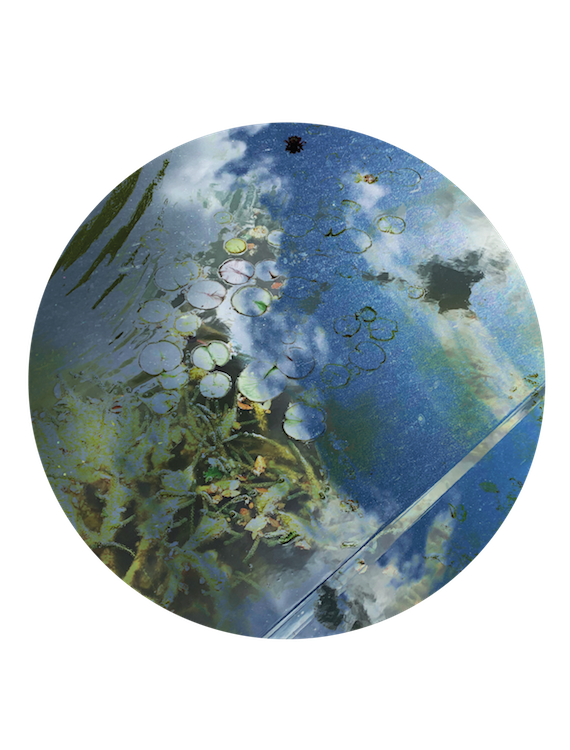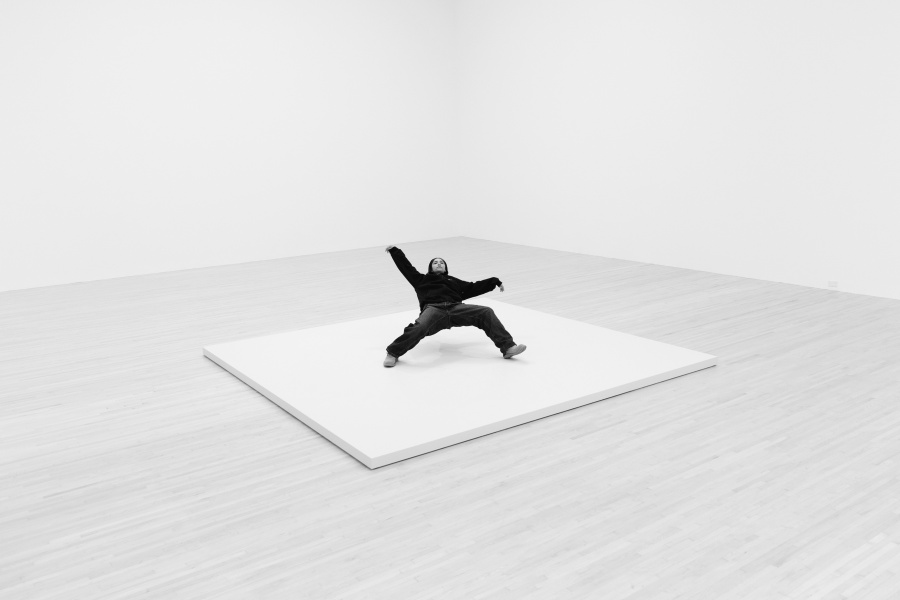“The ground is a pedestal for readymade works” – Eric N. Mack
Eric N. Mack is perhaps best known for his stretched, warped vision of painting that spans architecture, fine art and fashion; a perspective that he brings to “Pedestrian Profanities”, a show curated by the artist and presented at Simon Lee Gallery, New York, until 12th December. On the occasion of the exhibition, Olu Odukoya interviews Mack on his selection of works, and on the interplay between them.
Olu Odukoya: Eric, how did this project come about? How long was the curation process?
Eric N. Mack: Over the summer of 2020, I was invited to curate a show for Simon Lee’s 64th street space. Immediately, there were artists and experiences that I wanted to present, and I thought of a series of vignettes for the viewer to experience. When you step off the elevator, you’re accosted by an inverted stop sign made of a butcher’s block, and towards the back the patio’s framing is interjected by two different works that use storefront mannequins; at the same time, the works in the exhibition are wholly bound to the architecture. This long corridor of the gallery provides several site lines that make images shared amongst the artists in the show. It took me several weeks to refine the artist list. I covet the experience of viewing these artworks, which possess a unique texture and materiality: Akeem Smith’s Section 8, Cinzia Ruggeri, Susan Cianciolo, and Samuel Hindolo. I am in constant conversation with Abigail Deville, Torey Thornton, Andy Robert, and Kandis Williams, and I feel lucky to contextualise their work.

Photographs are by Dan McMahon

Samuel Hindolo, Soliloquy and Loop, 2020, courtesy Simon Lee Gallery, New York

“The radicality of the shaped painting poses questions to a given architecture.”
OO: How does the work on show relate to your own practice?
ENM: I wanted a way to discuss various visual traditions to get to feel transgression that it is a sense the body understands. The show highlights questions that deal with the space. The radicality of the shaped painting poses questions to a given architecture. The measurement of space is understood using surrogates of the body, like a handbag. The sensuality of surfaces communicates through material reactions to light. The ground is a pedestal for readymade works – to me this is a confrontational act. It’s sharing the same floor as the viewers’ feet. It allows for the handmade, seemingly delicate textile to become a framing device. The diversity of surfaces and material shifts allows for a poetic to guide the viewer.
OO: Is there an overarching connection between the artworks in the show? Why put these artists together?
ENM: One of the exhibition’s constellations is about transferring understanding, an instance when the viewer becomes wearer/an artwork becomes embodied. Most of these artists have not shown together in such an intimate space. I am interested in the irreverence of modernism. The ruptures that define the profane. The works and practices have visual relationships that are mostly unspoken. The subject of Andy Robert’s work Smoking Gun comes from a digitised watercolour of a marooner, a Black slave that saw to their liberation. A figure engaged in the refusal of slavery. Almost a pointillist rendering, the work accumulates and obliterates the figure all at once. This work lies across from Susan Cianciolo’s drawing, Two Maroon Women Watercolor on Paper, This connection appeared from the selection of works. The depth of the drawing reflected in maroon as colour, almost blood red. One figure in a pirouette and the other seated in repose. The movement and freedom of the body are inferences from these selections, but the representation of maroonage in vastly different formal strategies makes for a powerful link.

Susan Cianciolo, heaven, otherworld, nirvana, 2016–2020, courtesy Simon Lee Gallery, New York

OO: What was your system for selecting the works? For example, did you base this on a certain time, or certain materials?
ENM: Selections came from studio visits either in person or on Zoom. I also reached out to Federico Vavasorri, gallerist to the late Cinzia Ruggeri, a fascinating Milan-based artist and designer. I am honoured to show her last work, Multicolor, from 2019. Abigail Deville’s sculpture Dark Matter No Matter and Samuel Hindolo’s painting Untitled were made for the exhibition. I wanted to have a mix of material production that would speak to one another. A work completed in the present or, in the case of Section 8, made for the previous season, Spring 2020, to Susan’s drawing made in 2001.
OO: Something I like about the show is how it explores the bridge between different medias – for example art, fashion, and architecture – which is interesting. Is this something you’ve previously explored in your own work?
ENM: Yes, I feel like it’s my job to fuse disparate relationships, formally, conceptually, or otherwise.
“I wanted to have a mix of material production that would speak to one another. A work completed in the present or, in the case of Section 8, made for the previous season.”

Kandis Williams, co-response-ability with/for the unknown Other, 2019-20, courtesy Simon Lee Gallery, New York

Torey Thornton, A Height's Presence In Isolating, Who's Do You Put
Yourself In And Why (Olive New York Crazy City), 2020, courtesy Simon Lee Gallery, New York
OO: It’s interesting to see the work of the late Cinzia Ruggeri in the show. The multicolour work from 2019 was her last. Could you tell us a little about how and why that piece came about?
ENM: I was excited to include Cinzia Ruggeri, Her career exemplifies much of the concept of the exhibition. Her garments act as performance artefacts, and physical prompts to the wearer that can be seen in video documentation as well as runway footage from her shows in the 80’s. Often pictorial and architectural. I was interested in the work Multicolour, because of the way it smuggled so much in a Italian luxury handbag, a miniature building inspired by the Bauhaus style, meaning “Building House”. The compartments each colour-coded. Bauhaus institutional concept allowed for spaces of craft and fine art under one roof. I imagine each compartment giving space for various tools, sewing kit, watercolour set, measuring tape, scissors, chemistry set.
OO: Another work I’d be interested to hear more on is Abigail Deville’s sculpture Dark Matter No Matter.
ENM: Dark Matter No Matter is a work made for the exhibition by Abigail Deville, it comes after a series that use mannequin body parts as a emotive motif. The work is in relation to her public work in Madison square park titled Light of Freedom. The use of painted mannequins question a space of empathy, a standardised scaling to the viewer’s body (even in fragmentation) as well as a reformatting of an anthropomorphic form of display. These figures are tied to architectural structures that appear as receptors for the cosmos. The adornment of the body through the use of jewellery, studs, gilded crucifixes and pearl necklaces feel like an other worldly technology. Coded beauty to aid in the transportation of viewer.
OO: There is a sense that your selection of artists is also an invitation to the viewer to go and find out more about these figures themselves. Was this consciously inscribed into the show, or a by-product?
ENM: Yes absolutely, I think that is most important in a group show for the viewers to continue to the work. I also felt the viewer would inevitably learn about this work sooner rather than later, so why not now? On closer inspection many of the works hold compelling histories that may not be so clear at first; motifs proposed in the language of each work. I implore you to take a close look at the Kandis Williams’ works, Iconic Face of Death Mask II, what you cannot anticipate is the reflective quality of the plexi surface, it brings you into the picture, making it hard to photograph without the viewer’s apparent subjectivity.





